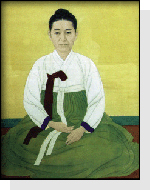- Park In- hwan (1926~1956)
- Park Su- geun (1914~1965)
- Kim Yu- jeong (1908~1937)
- Lee Hyo- seok (pen name Gasan) (1907~1942)
- Kim Dong- myeong (Choheo) (1901~1968)
- Han Yong- un (Buddhist name Manhae) (1897~1944)
- Namgung Eok (pen name Hanseo) (1863~1939)
- Yun Hui- sun (1860~1935)
- Yu In- seok (pen name Uiam) (1842~1915)
- Kim Byeong- yeon (pen name Nango) (1807~1863)
- Nam Gu- man (pen name Yakcheon) (1629~1711)
- Heo Mok (pen name Misu) (1595~1682)
- Heo Gyun (pen name Gyosan) (1569~1618)
- Heo Cho- hui (pen name Nanseolheon) (1563~1589)
- Sinsaimdang (1504~1551)
- Kim Si- seup (pen name Maewoldang) (1434~1493)
- Won Cheon- seok (pen name Ungok) (1330~ ?)
- Lee Seung- hyu (pen name Dongangeosa) (1224~1300)
Sinsaimdang (1504~1551)

She was a literary woman active midway through the Joseon dynasty, hailing from Gangneung.
She gave birth to and brought up Lee I (pen name Yulgok) to be a calligrapher and great scholar.
She thus is praised as a model of the representative, wise mother in Korea. Sinsaimdang was good-natured,
high-principled, and filially pious to her parents. She furthermore was bright and excellent in poetry and prose.
She also was dexterous in needlework and embroidery. She, who succeeded Angyeon´s painting style, is evaluated as the best female painter in Korea.
Her Chinese poems titled ‘Yudaegwanryeong-mangchinjeong’ (theme on love for an old mother) and ‘Sachin’ (theme on filial piety) are well known. At 19, she was married to Lee Won-su (Deoksu Lee family line), who held a supervisory office in the government. She moved to Seoul, Gangneung, and Baekokpori in Bongpyeong-myeon, Pyeongchang-gun, as her husband was transferred to serve his office. At 33, in 1536 (31st year of King Jungjong), she dreamed of a dragon and then had her third son Lee I (Yulgok). In 1551 (the sixth year of King Myeongjong), she died at 48 years of age due to serious illness while her husband was dispatched to Gwanseo district (currently Pyeongan and Hamgyeong Provinces in North Korea) to serve Suun-pangwan (office in charge of water-surface transportation).
The government (at that time) posthumously granted her a government post. One hundred pieces of her mementoes including her son Yulgok´s are kept in Ojukheon (her house) in Gangneung They include a Dangseo folding screen, as well as the paintings Sansudo (landscape), Noando (wild goose), Yeonrodo (lotus), Maehwado (Japanese apricot flower), Pododo (grape), Chochungdo (insects on flowers), and embroidered folding screens. She was designated as the cultural person of this month in May 1992, by the Ministry of Culture and Sports.
Her Chinese poems titled ‘Yudaegwanryeong-mangchinjeong’ (theme on love for an old mother) and ‘Sachin’ (theme on filial piety) are well known. At 19, she was married to Lee Won-su (Deoksu Lee family line), who held a supervisory office in the government. She moved to Seoul, Gangneung, and Baekokpori in Bongpyeong-myeon, Pyeongchang-gun, as her husband was transferred to serve his office. At 33, in 1536 (31st year of King Jungjong), she dreamed of a dragon and then had her third son Lee I (Yulgok). In 1551 (the sixth year of King Myeongjong), she died at 48 years of age due to serious illness while her husband was dispatched to Gwanseo district (currently Pyeongan and Hamgyeong Provinces in North Korea) to serve Suun-pangwan (office in charge of water-surface transportation).
The government (at that time) posthumously granted her a government post. One hundred pieces of her mementoes including her son Yulgok´s are kept in Ojukheon (her house) in Gangneung They include a Dangseo folding screen, as well as the paintings Sansudo (landscape), Noando (wild goose), Yeonrodo (lotus), Maehwado (Japanese apricot flower), Pododo (grape), Chochungdo (insects on flowers), and embroidered folding screens. She was designated as the cultural person of this month in May 1992, by the Ministry of Culture and Sports.
최근 업데이트 2023-01-10


